 NCDC
/ Climate Monitoring
/ SPI
/ Search
/ Help
NCDC
/ Climate Monitoring
/ SPI
/ Search
/ Help

|
The Standardized Precipitation Index (SPI) is a way of
measuring drought that is different from the Palmer drought index (PDI).
Like the PDI, this index is negative for drought, and positive for wet conditions. But the SPI
is a probability index that considers only precipitation, while Palmer's indices are water
balance indices that consider water supply (precipitation), demand (evapotranspiration) and
loss (runoff).
The seven maps below show the August 2008 spatial patterns of SPI for seven different periods ranging from one month (short-term conditions) to 24 months (long-term conditions). When taken together, they give a combined geographical and temporal picture of the severity of precipitation anomalies. On these maps, the red shading denotes dry conditions while the green shading indicates wet conditions. |
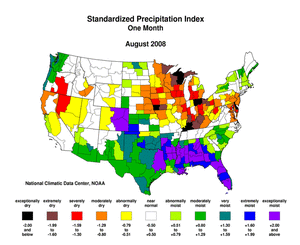 larger image 1-month SPI |
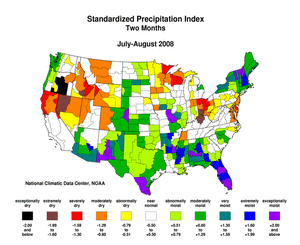 larger image 2-month SPI |
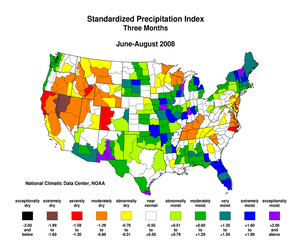 larger image 3-month SPI |
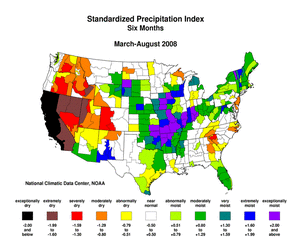 larger image 6-month SPI |
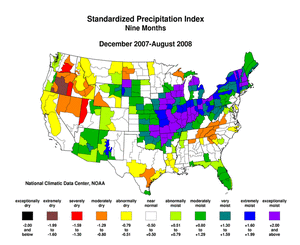 larger image 9-month SPI |
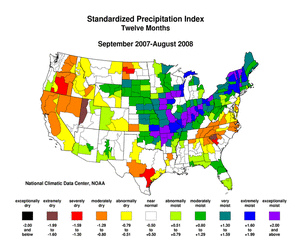 larger image 12-month SPI |
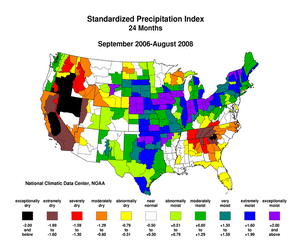 larger image 24-month SPI |

Why is it Hard to Measure Drought?
The wide variety of disciplines affected by drought, its diverse geographical and temporal distribution, and the many scales drought operates on make it difficult to develop both a definition to describe drought and an index to measure it. Many quantitative measures of drought have been developed in the United States, depending on the discipline affected, the region being considered, and the particular application. Several indices developed by Wayne Palmer, as well as the Standardized Precipitation Index, are useful for describing the many scales of drought.
Common to all types of drought is the fact that they originate from a deficiency of precipitation resulting from an unusual weather pattern. If the weather pattern lasts a short time (say, a few weeks or a couple months), the drought is considered short-term. But if the weather or atmospheric circulation pattern becomes entrenched and the precipitation deficits last for several months to several years, the drought is considered to be a long-term drought. It is possible for a region to experience a long-term circulation pattern that produces drought, and to have short-term changes in this long-term pattern that result in short-term wet spells. Likewise, it is possible for a long-term wet circulation pattern to be interrupted by short-term weather spells that result in short-term drought.
The Palmer Drought Indices
The Palmer Z Index measures short-term drought on a monthly scale. The Palmer Crop Moisture Index (CMI) measures short-term drought on a weekly scale and is used to quantify drought's impacts on agriculture during the growing season.
The Palmer Drought Severity Index (PDSI) (known operationally as the Palmer Drought Index (PDI)) attempts to measure the duration and intensity of the long-term drought-inducing circulation patterns. Long-term drought is cumulative, so the intensity of drought during the current month is dependent on the current weather patterns plus the cumulative patterns of previous months. Since weather patterns can change almost literally overnight from a long-term drought pattern to a long-term wet pattern, the PDSI (PDI) can respond fairly rapidly.
The hydrological impacts of drought (e.g., reservoir levels, groundwater levels, etc.) take longer to develop and it takes longer to recover from them. The Palmer Hydrological Drought Index (PHDI), another long-term drought index, was developed to quantify these hydrological effects. The PHDI responds more slowly to changing conditions than the PDSI (PDI).
The Standardized Precipitation Index
While Palmer's indices are water balance indices that consider water supply (precipitation), demand (evapotranspiration) and loss (runoff), the Standardized Precipitation Index (SPI) is a probability index that considers only precipitation. The SPI is an index based on the probability of recording a given amount of precipitation, and the probabilities are standardized so that an index of zero indicates the median precipitation amount (half of the historical precipitation amounts are below the median, and half are above the median). The index is negative for drought, and positive for wet conditions. As the dry or wet conditions become more severe, the index becomes more negative or positive. The SPI is computed by NCDC for several time scales, ranging from one month to 24 months, to capture the various scales of both short-term and long-term drought.
 Selected References
Selected References
Guttman, N.B., 1991: A sensitivity analysis of the Palmer Hydrologic Drought Index. Water
Resour. Bull., 27, 797-807.
Guttman, N.B., 1998: Comparing the Palmer Drought Index and the Standardized Precipitation
Index. J. Amer. Water Resour. Assoc., 34, 113-121.
Guttman, N.B., J.R. Wallis, and J.R.M. Hosking, 1992: Spatial comparability of the Palmer Drought
Severity Index. Water Resour. Bull., 28, 1111-1119.
Heddinghaus, T.R. and P. Sabol, 1991: A review of the Palmer Drought Severity Index and where
do we go from here? Proceedings, 7th Conf. on Appl. Climatol., 10-13 September 1991,
Boston: American Meteorological Society, 242-246.
Heim, Jr., R.R., 2000: Drought indices: A review, Chapter 11. In
Drought: A Global Assessment (Donald A. Wilhite, ed.).
(Routledge Hazards and Disasters Series, volume 1). Routledge: London, 159-167.
Karl, T.R., 1983: Some spatial characteristics of drought duration in the United States.
J. Climate Appl. Meteor., 22, 1356-1366.
Karl, T.R., 1986: The sensitivity of the Palmer Drought Severity
Index and Palmer's Z-Index to their
calibration coefficients including potential evapotranspiration.
J. Climate Appl. Meteor., 25, 77-86.
Karl, T.R., R.W. Knight, D.S. Ezell, and F.T. Quinlan, 1986: Probabilities and precipitation
required to end/ameliorate droughts. Historical Climatology Series 3-16,
Asheville: National
Oceanic and Atmospheric Administration, National Climatic Data Center, 315 pp.
Karl, T., F. Quinlan, and D.S. Ezell, 1987: Drought
termination and amelioration: Its climatological
probability. J. Climate Appl. Meteor., 26, 1198-1209.
Keetch, J.J. and G.M. Byram, 1968: A drought index for forest fire control.
Paper SE-38, Forest Service Research, U.S. Dept. of Agriculture.
Kogan, F.N., 1995: Droughts of the late 1980's in the United States as derived from NOAA polar-
orbiting satellite data. Bull. Amer. Meteor. Soc., 76, 655-668.
Palmer, W.C., 1965: Meteorological drought. Research Paper No. 45. U.S. Weather Bureau.
[NOAA Library and Information Services Division, Washington, D.C. 20852]
Palmer, W.C., 1968: Keeping track of crop moisture conditions, nationwide: The new crop moisture
index. Weatherwise, 21, 156-161.
Wilhite, D.A. and M.H. Glantz, 1985: Understanding the drought phenomenon: The role of
definitions. Water International, 10, 111-120.

 NCDC
/ Climate Monitoring
/ SPI
/ Search
/ Help
NCDC
/ Climate Monitoring
/ SPI
/ Search
/ Help



